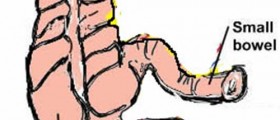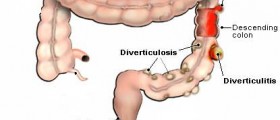
The symptoms take more time to appear (often weeks pass before anything is noticed), which is why a person many times finds out much later that something is wrong. The condition may even go unattended owing to its understated symptoms and because of that, timely diagnosis many times becomes more difficult.
Inflammation of the Appendix
The appendix is a small, elongated organ protruding from the proximal part of the large bowel called the cecum. The organ is loose and moves freely in the abdominal cavity, although a thin tissue anchors it to the bowel. The opening of the appendix may be easily blocked with stool particles, foreign bodies, worms or, more rarely, neoplasms (cancers) of the bowel – a scenario more probable in older patients. Once blocked, the appendix gets easily inflamed. Gangrene and subsequent rupture may soon take place.
Symptoms of Grumbling Appendix
Pain around the appendix, usually perceived on the outer part of the body as pain located around the navel is one of the first signs. Of course, a layman cannot know if it actually has anything to do with the appendix. Yet, the pain related to grumbling appendix is known to get worse when the sufferer moves or walks.
Therefore, in any case of abdominal pain, one should seek the help of a physician.
Tenderness around that area can also appear, severe pain appearing when the affected spot is pressed. Additionally, loss of appetite and constipation may occur in some cases, along with nausea and vomiting, even though these symptoms are quite rare.
Upon visiting your doctor, he/she will conduct a physical exam to localize the pain, pressing the appendix to make sure that it is the source behind your symptoms. Then, he/she will probably order a CT scan of the abdomen.
As far as the treatment is concerned, sometimes doctors recommend a surgical intervention, out of fear that the condition might actually be acute, but slowly developing. This is probably the best solution, because it might stop any future problems with the appendix.
Another way of treating the condition includes taking prescription medication. The doctor may prescribe antibiotics in high doses in order to prevent the advancement of chronic appendicitis into an acute one.
Why is Ileostomy Performed?
Ileostomy is a surgical procedure which is conducted in the case of serious diseases of gastrointestinal tract. It means forming of an artificial opening on the front side of the abdomen so the stool does not take the usual path. The stool is then passed into the sac which is attached to the stoma.
There are several types of ileostomy, loop ileostomy, end ileostomy, ileo-anal pouch and continent ileostomy. The first one means that small intestine is ending in stoma. This is short-term option done when a surgeon removes only the part of the large intestine and right after the healing is complete the small intestine is back into the abdominal cavity. This is done mainly in cases of colon cancers. The end ileostomy is basically for a life time as it is done when the colon and rectum are removed due to serious illnesses and the ileum is surgically connected to the stoma.
Ileo anal pouch (J pouch) is used in case of colon and rectal removal. This pouch is surgically created out of the ileum and is finally connected to the sphincter muscle of the anus. These pouches are more esthetic than other forms of ileostomy.
On the other hand, a person may have difficulties with prompt urge to empty the pouch. A continent ileostomy is rather similar to the previous one but there is also a valve implanted into the skin which has a role of emptying the pouch. This is done by a tiny tube.
In rare cases ileostomy does not function properly in the beginning. But if the stoma does not show any signs of activity within 6 hours and this is accompanied by nausea or even cramps, there is high possibility that obstruction has developed. This is supposed to be immediately reported to the doctor. To avoid these complications patients are due to follow specific dietary regimes.
To conclude, many reasons may exist behind the inflammation of the appendix, being the condition which is commonly referred to as grumbling appendix. Fortunately, often, the symptoms of this condition are easy to be noticed and the person can seek medical assistance once he/she notices any pain or discomfort around the appendix or abdominal area.
Keep in mind that timely treatment can prevent grumbling appendix from getting worse. Thus, make sure you contact your doctor as soon as the symptoms appear.
- www.nhs.uk/conditions/appendicitis/symptoms/
- www.nhs.uk/search/?collection=nhs-meta&query=grumbling+appendix
- Photo courtesy of Jimee, Jackie, Tom & Asha by Flickr: www.flickr.com/photos/wilderdom/228781838/

















Your thoughts on this
Loading...